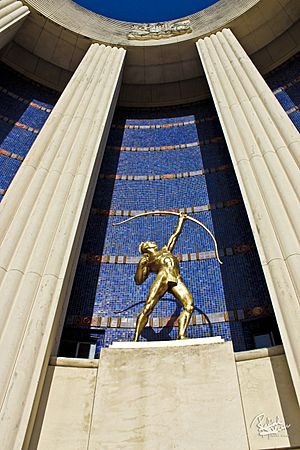Texas Centennial Exposition facts for kids

The Texas Centennial Exposition was a huge world's fair held in Dallas, Texas. It ran from June 6 to November 29, 1936, at Fair Park. This big event celebrated 100 years since Texas became independent from Mexico in 1836. It also showed off the unique culture of Texas and the American West.
More than 50 buildings were built just for this exposition. Many of these buildings are still standing today and are great examples of Art Deco style. Over six million people visited the fair, including US President Franklin D. Roosevelt. The exposition was very important because it helped Dallas during the difficult time of the Great Depression.
Why the Exposition Happened
The Texas Centennial Exposition was a big party to celebrate Texas's 100th birthday. Texas gained its independence from Mexico in 1836. The fair also celebrated the rich history and culture of Texas and the American West.
Three major Texas cities wanted to host this special event: Dallas, Houston, and San Antonio. Dallas was chosen by the Texas Centennial Commission. This was because Dallas offered the most money to host the fair, had the existing buildings of the State Fair of Texas, and had strong local leaders.
George Dahl led a team of architects who designed the more than 50 buildings for the exposition. These buildings were built at Fair Park, which was a large area of 178 acres. About 30 of these original buildings are still there today. They form one of the largest groups of world's fair buildings left in the United States. The most important building is the Texas Hall of State, which was finished after the fair had already started.
Exciting Events and Attractions
The Texas Centennial Exposition took place at Fair Park in Dallas. It ran from June 6 to November 29, 1936. Over 6.3 million people visited the fair, and it cost about $25 million. The exposition helped Dallas a lot during the Great Depression. It created more than 10,000 jobs and boosted the local economy by $50 million.
One of the most popular attractions was the Cavalcade of Texas. This was a historical show that covered 400 years of Texas history. Another popular spot was the Hall of Negro Life. This was a very important exhibit. It is believed to be the first time African-American culture was recognized at a world's fair. The Hall had four beautiful murals painted by the famous artist Aaron Douglas.
The Texas Centennial Olympics were held in the Cotton Bowl. This event was special because it hosted the first integrated public sports competition in the history of the Southern United States. This meant people of different races competed together.
A famous play called Macbeth was also performed at the fair. It was directed by Orson Welles and had an all-black cast. This play was shown from August 13–23 in a new outdoor theater. Many people talked about this performance, and it attracted large, excited crowds. For many, it was their first chance to see professional African American actors. The fact that people of all races could sit together was a new experience for theatergoers in Dallas.
President Franklin D. Roosevelt visited the exposition on June 12. His visit was widely reported. The film The Big Show starring Gene Autry was filmed at the fair. It shows many of the buildings and events from the exposition.
The fair needed a lot of publicity. However, there weren't many photos of Texas for advertising. So, the exposition hired Polly Smith to travel around the state. She took pictures to tell the story of Texas.
After a successful five-month run, the Texas Centennial Exposition closed. The exhibits were changed, and the fair reopened the next year. It was then called the Greater Texas & Pan-American Exposition.
Lasting Impact
The buildings at Fair Park from the Texas Centennial were recognized as a National Historic Landmark in 1986. This means they are very important historical sites.
In October 2010, the National Building Museum in Washington, D.C. opened an exhibit. It was called Designing Tomorrow: America’s World’s Fairs of the 1930s. This exhibit featured the Texas Centennial Exposition very prominently.


